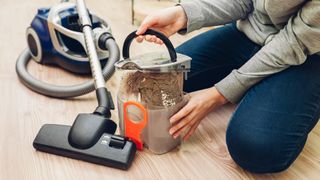Below, we explore how often you should replace a vacuum cleaner filter and how to get the job done quickly, with the help of our expert Pablo Montero, CEO of Lupe Technology (opens in new tab). This will help you keep your vacuum in the best condition so that your investments last and you know how to clean a carpet (opens in new tab) as efficiently as possible. It’s also worth exploring the best vacuum cleaners (opens in new tab), so you can decide on a machine that suits your needs. There are many on the market, from robot to upright, so you can find the right size and type to fit your home and cleaning habits. It’s worth noting that choosing between a bagged or bagless vacuum will affect the maintenance required, such as either changing the bag frequently or replacing the filter.
How often should you replace a vacuum cleaner filter?
Vacuum cleaners are one of the most used appliances in the home, so it’s understandable that they will need regular servicing to keep them working their best. If you’re vacuuming weekly (or still wondering how often you should be vacuuming (opens in new tab)), dust and dirt can quickly build up in the filter which will prevent the machine from thoroughly cleaning floors and furnishings. There are also different types of filters, which will impact how often your particular choice needs replacing. Pablo Montero, CEO of Lupe Technology (opens in new tab) and ex-engineer at Dyson, has explained the common types: “Most vacuum cleaners will have two filters - pre-motor and post-motor. In general, the pre-motor filter would be made of foam or fabric and can handle a larger quantity of dust before needing cleaning. The post-motor filter would more likely be folded or pleated and made from a finer filter medium. The vacuum cleaner manufacturer will typically specify the service interval for either of these filters and they would be within my guidance above in terms of likely time periods to be concerned with. The filters after the motor will come in different grades (or rather how finely they capture dust) and you would generally find for a given size, a higher grade of filter will need cleaning or replacing more frequently than a lower grade.” Many filters are also washable, meaning you can forgo replacing them with regular cleans once every 3-6 months. However, in a vacuum cleaner with a non-washable filter, Pablo recommends replacing it “at a minimum every 6 months, at the most every 2 years.”
How to replace a vacuum cleaner filter
- Locate the filter Finding the filter should be an easy step to get started with. In bagged vacuums, the filter grid will most likely be positioned behind the bag. Alternatively, some bagless models may have multiple filters in different locations so it’s always worth checking the manufacturer’s guide.
- Prepare your replacement filter Most filters will be a standard size however if it’s slightly too big for your machine, it’s easy to cut down. To avoid any issues with choosing the right replacement, we recommend double-checking your vacuum’s manual beforehand.
- Secure the new filter The third and final step to replacing a vacuum cleaner filter is to secure it in the filter grid, not forgetting any secondary filters that a bagless model may have. Once this is done, simply dispose of the old filter, close the lid of your vacuum and you’ll be ready to start cleaning! Discover more guides for the home… Best top load washers (opens in new tab) Best dishwashers (opens in new tab) Best dryers (opens in new tab) Best steam mops (opens in new tab) Best robot vacuums (opens in new tab)







